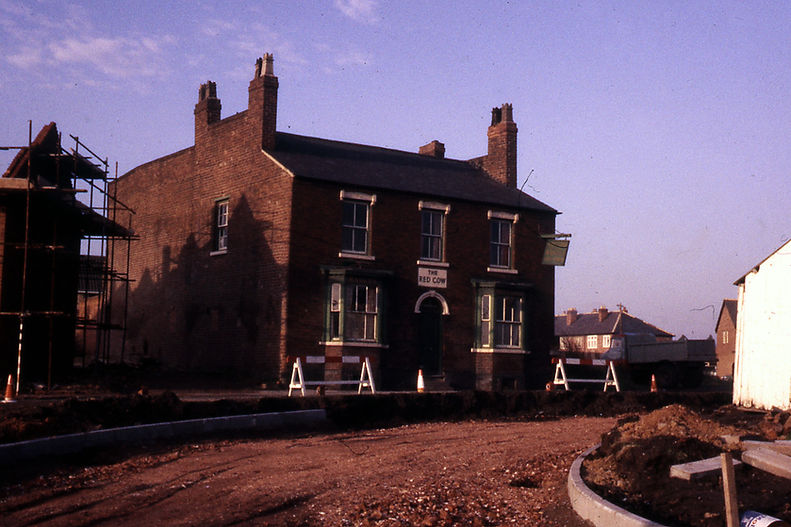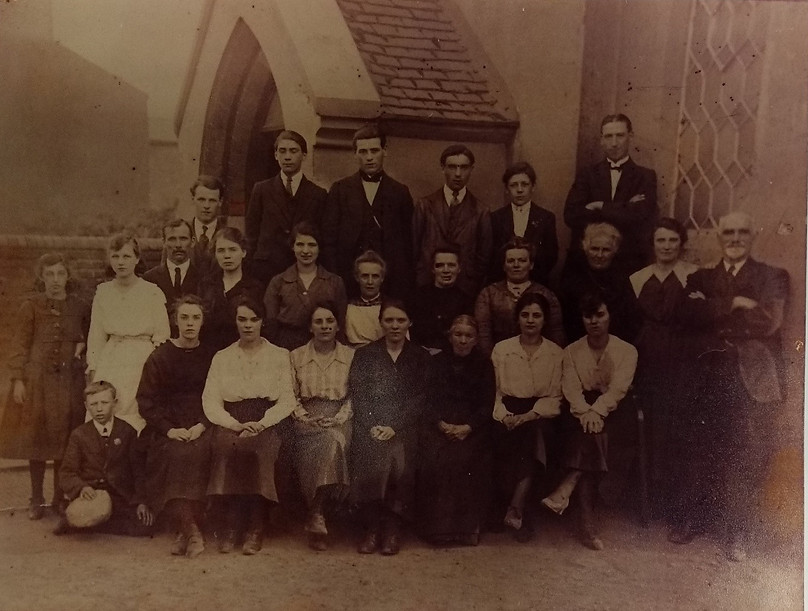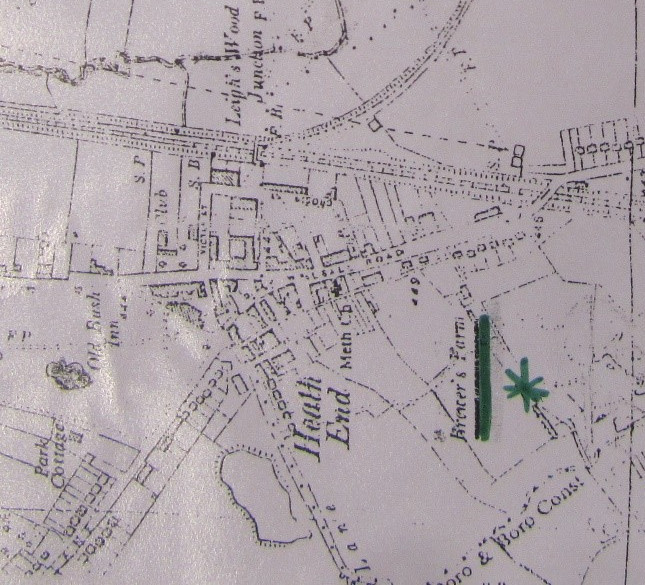A History of Heath End, Pelsall

Photograph above, courtesy of Mr A Weller, Chairman of Pelsall History Centre
My research for the history of Heath End, Pelsall took me to Pelsall History Centre where I found plentiful information taken over many years and from many different sources, for which I am extremely grateful. This plethora of ephemera revealed a very fascinating and colourful long lost and largely forgotten about community.
It could be said that today, Heath End, Pelsall is rather overlooked as we pass through it from Rushall to Pelsall, however, back in the day, Heath End, also known as Cod End was considered to be a hamlet quite detached from Rushall and Pelsall.
Heath End had a vibrant population and workforce and was used as inspiration for the novels Essie and No Work Today by Flora Pearce.
In 1861 there were said to be 23 occupations of Heath End residents including 5 nailmakers and 11 ironworkers. The ironworkers may have been employed by the nearby Wilkes Foundry at Mouse Hill.
Shortly after his census was taken, the open land behind and in front of The Red Cow public house was subject to somewhat of an explosion of development.
By the 1881 census, there were 23 miners and 20 ironworkers out of a total workforce of 103.
In 1895 there was typhoid fever present at Heath End, one being in Cross Street. It was thought that it possibly originated in 3 houses situated in Slacky Lane, Mann’s Buildings and Starkey Cottages as the drain there was un trapped.
In 1901 coal mining in Heath End was quite near the surface. When standing on the common, trucks running along the tramways beneath the common could be felt under foot.
Due to this close proximity there were many cave ins and the night sweepers of horse manure etc put their collections into the holes. As a consequence, grass in these areas became quite lush.
According to Harry Farmer, on one occasion some shaft seams came into the open and the men began to claw coal out as the women loaded it into baskets and dragged them to the surface where the coal was taken away.
One of these women was called Gemima Feeney who had lots of children, but was not married. It was said that during her work time she used to nip to her home to see if the kids were alright then she would go back to work to bring coal to the surface.
Heath End Pool is situated above the old mine workings.
By 1902 Heath End Brickworks, otherwise known as The Marl Hole featured prominently on the map of Heath End, Pelsall.
By 1914 there were 18 shopkeepers serving this small community including Eli Law who kept the shop and post office, Arthur Stokes, the butcher, Llewelyn Hughes, furniture dealer, Eliyah Dilkes, the beer retailer, George Crook, second hand clothes dealer, Edith Clayton, newsagent, Mary and Bellamy, draper, Ernest Bennett, Beer Retailer.
By 1928, George Bullock was the Grocer, George Crook, cycle dealer, Betsy Down, butcher, Maud Lawrence, draper, Henry Loveridge, Coal Merchant, John Thomas Shaw, draper, Benjamin Millard, confectioner, Walter Snape, farmer of Fairy Field Farm and A D Gibbons ran the outdoor between Allens Lane and Chapel.
In Heath End, large families with anything from eight to twelve children were considered normal.
The women were looked after by local midwives for a charge of approx 5 shillings, not always paid. The midwife attended the birth and gave care afterwards for up to 10 days. In those days neighbour's could always be relied upon to come in and look after things while the mother remained in bed.
The midwife for Heath End was Mrs Sweet who lived by The Old Bush Inn and for Pelsall there were Comfort Davies and Mercy Poxon.
Tradition and superstition was strong surrounding childbirth and women were not allowed to enter the house or shop of another until they had first been 'Churched' – A short service of thanksgiving for the safe delivery of a child.
Many in Heath End were poor and some new mum's took advantage of the free bundles of clean white rag available from Pelsall vicarage. This was used for nappies and binders.
Christening took place within 8 weeks of the birth and were always good occasions with special clothing bought for the baby.
In 1992, Mrs Elizabeth Holden, then aged 91 recalled that there were 2 water wells in the yard of Birchin Cottages that were down the gully going to the Railway from Victoria Square, Heath End. They were still in use when she lived in Victor Street as a youngster.
There was 1 pump in Bloomer Street, 1 in the big yard and also 1 for Angel Row by the old Mission Chapel, she recalled.
In the absence of Social Security at this time, it was interesting to read in the St Michael’s Church magazine that Mrs T Williams of Heath End desires to express her sincere gratitude for the kind help afforded her towards the cost of a sewing machine which has placed her in a position to undertake work. A wonderful example of the strength of a close knit community in Heath End, Pelsall.
The Heath End youth was also very much accounted for with its Heath End Youth Club being established before 1952. In 1952 the Heath End Youth Club was meeting at their Centre on a site given by and next to the Weslyan Chapel.
In 1961 The Heath End Youth Club opened their new centre in the grounds of Heath End School.

Map above, courtesy of Mr A Weller, Chairman of Pelsall History Centre

Map above, courtesy of Mr A Weller, Chairman of Pelsall History Centre
Back in the day Heath End, Pelsall consisted of Allen's Lane, Brewers Terrace, Victor Street, The Methodist Chapel, Fairy Fields, Brewers Farm, Walsall Road, The Old Bush Inn, The Red Cow, The Royal Exchange and The Marl Hole.
This close knit hamlet was totally self sufficient in every way having its own shops, post office, a chapel, a farm and three serving public houses two of which were much more than a public house.
The Royal Exchange ceased to exist as a public house many many years ago and I have been unable to find any evidence of what it once looked like.
Although The Red Cow building does still exist it was converted into flats some years ago.
The Old Bush however is clinging on by the skin of its teeth as it has been subject to fire damage and vandalism for a number of years, a far cry from how it was back in the day as seen below.

The Old Bush Inn
Photograph above, courtesy of Mr A Weller, Chairman of Pelsall History Centre
In 1991 Mrs Dukes recalled that the nearest weekend to October 7th being called Wakes Week. She went on to say:
We had a fair on the common in front of The Old Bush Inn or in The Old Bush Inn Field at Heath End. At other times it was held in Stanley’s field at the back of the Coop in Pelsall.
Wakes week was a very happy time for us children, best clothes and a penny or two for rides or sweets.
We also had ‘Wildigs Puppet Show’ and ‘Holloways Small Theatre’ doing plays etc, Maria Martins Murder in the Red Barn, East Lynn, The Face at the Window and many more.
A German Band came every so often to play round the camp in Victoria Square, Heath End. Also, a man bought with him a dancing bear.
Two weeks before the 1914 – 1918 war started there was a western show on the Bush field, but on the night that the war was declared all of the performers vanished leaving all their tents etc behind.
It was all stored at Hughes’ big house, but no one ever came back to claim it.
1919 The Pelsall Wesley and Pelsall Albion Cricket Clubs amalgamated to become Pelsall Cricket Club at the pitch to the rear of the Old Bush Inn

Photographs of the Red Cow, above and below, courtesy of Mr A Weller, Chairman of Pelsall History Centre


Regulars at The Red Cow in the late 1800's
The Footballers of Heath End used to practice on the Bush Field behind the Old Bush Inn although the ground belonged to The Red Cow, being sold off by Wolverhampton and Dudley Brewers to Banks in around 1950.
The Red Cow’s cellar was used as a temporary mortuary from the Victorian times and to at least as late as during WW2.
In addition to this, inquests were often heard at The Old Bush Inn for those who had committed suicide in the nearby Marl Hole, following which victims were most likely taken to the Red Cow’s mortuary.
Sadly, suicides at Marl Hole were frequent during desperate times.
One incredibly sad incident concerned an 11 year old boy who had apparently committed suicide at the nearby Marl Hole after being chastised.
The boy had originally lived and his family on Walsall Road near to The Red Cow, however 12 months earlier his mother committed suicide by taking poison and then his father attempted to commit suicide following which he became an inmate of Burntwood Lunatic asylum.
After losing his parents, Austin Frank Loveridge, went to live with his older sister who also lived on Walsall Road.
The inquest relating to his suicide reads: Highly strung, the lad had got into trouble on two occasions that week and had talked of going away.
Initially it was thought that Austin had run away, after he was missed from home on Thursday 23rd January, however on Monday 27th January 1930, his fully clothed body was found in Marl Hole. It was a clayey surface by Marl hole and the boy was wearing newly studded boots, but there were no signs that he had slipped down the bank accidentally.
Following this incident, it is likely that Austin’s body would have been taken to the nearby mortuary at The Red Cow, like his mother before him.

Marl Hole as seen above - photograph courtesy of Mr A Weller, Pelsall History Centre
Christianity was also a big part of life in Heath End and the progress of Methodism began early.
In the 1830’s 'Billy' Williams, the Blacksmith of Heath End was well known to be an earnest christian and held religious meetings in his shop, gathering those who wished to be saved from their sins and to find their new lives in Christ.
'Billy' Williams' little blacksmith shop was situated on the fringe of the common at Heath End, Pelsall.
Meetings were held around his anvil and he rejoiced in seeing numbers bought from darkness into light.
It was said that the foundations of the future Methodist Church were laid on the hearth of 'Billy' Williams and his blacksmiths shop.
Heath End Chapel was built in 1867.
In 1891 it was reported in St Michael’s Church May magazine that the increasing population of Heath End had provoked a serious consideration for the provision of a Mission Room at Heath End.
In 1892 Mr C F Lloyd of Lichfield very generously offered a site for the Mission Room at Heath End.
In 1893 a plan of the site of St Michael’s Mission Room at Heath End was drawn by Mr Hough to the delight of the vicar.
In 1905 Heath End Chapel was renovated and a pipe organ was installed.
In 1908, on May 30th the Heath End Sunday School Anniversary was held in the afternoon, which was a musical service by children and the choir. The weather was superb, the school and chapel were packed, in the evening every available corner was taken, even to the pulpit. The collection made up a total of 21 pounds, the highest ever taken in a chapel. The first anniversary was held in 1868.
In 1910 The Church Army mission went to Heath End and the first cottage services were held with two lantern services in Church for the children.
In 1916, Harry Farmer spoke of the knocking down of a small chapel in the road running parallel to Walsall Road, known as occupation Road, running from Allens Lane to Brewers Drive. In 1992, Mrs Elizabeth Holden who was 91 at the time described the old Mission Hall by Angel Row as a ruin when she was a child.

Photograph courtesy of Mr A Weller, Chairman of Pelsall History Centre Heath End Chapel
In the 1920’s Heath End Chapel had a royal blue carpet stretching from the small double front doors to the pulpit. The off white wicker seated chairs, about 6 to 9 a row were positioned either side.
The chapel was situated on the main Walsall Road on the right hand side going towards the railway bridge.
After the second world war, most of the houses at Heath End were demolished which had quite and effect upon the Methodist chapel.
With a lowering congregation and low income the decision was made to close the chapel.

Photograph above, courtesy of Mr A Weller, Chairman of Pelsall History Centre
Some of the Congregation of Heath End Chapel in 1922

Photograph above, courtesy of Mr A Weller, Chairman of Pelsall History Centre
This wonderful photograph was taken of a group of Heath End women just before they were about to embark on a day trip leaving from Hannah Taylor's Outdoor Beer Shop.
Mrs E Holden recalled in 1992 at the age of 91 that they would all meet outside Hannah Taylor's outdoor beer shop in Victoria Square Heath End. This was a grand treat for them to go to places like Worcester, Shropshire and Shrewsbury. Just a few miles away to forget their troubles for a while. We children used to wait for them to come home, they would be singing the old songs like 'The Old Rustic Bridge by the Mill', 'Count Your Blessings' and 'The End of a Perfect Day' which is was for most of them.
Mrs E Holden was able to name some of the women on the photograph:
Mrs Taylor, Mrs Westly, Sally Clayton, Lilly Taylor, Mrs Bridgewood, Mrs Rigby, Mrs Lydall, Mrs Chatbound, Mrs Fletcher, Mrs Poxon, Mrs Clayton, Mrs Millard, Mrs Emiley Bridgewood, Mrs Albrook, Mrs Brown, Dora Selby, Ella Pallatina, Edith Morgan and others from Moss Pits.
Mrs Holden's mother, Mrs Hall is the lady sitting on the left with the white shawl round her neck.

Brewers Farm had been known as Heath End Farm. Brewers Drive was formerly known as Dukes Lane, then later as Heath End Lane, but now is known as Brewers Drive.
Fairy Fields is now called Commonside. In 1901 Fairy Fields was farmed by Elias Hudson who lived at a house named Barcelona, John Rowley was also a farmer of Fairy Fields in 1901 and he lived at Park Cottage. In 1911, John Adshead was the farmer of Fairy Fields and also lived at Fairy Fields.

Aldridge Urban District Council's clearance of the old slum properties of Heath End was welcomed by the community of Heath End after the Second World War. The demolition was part of the slum clearance programme in Brewer Terrace and Goscote Road, Heath End.
Modern dwellings took the place of the old cottages and nearly 100 families were re-homed from the area by the council.

